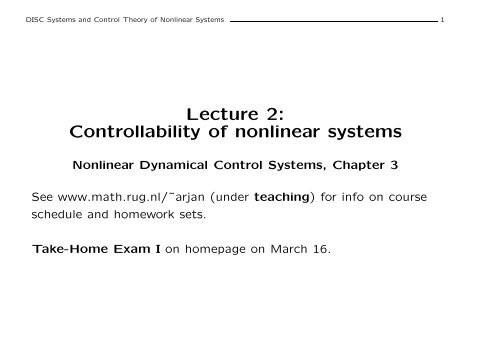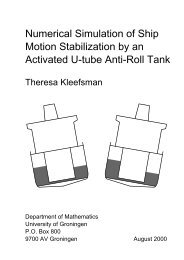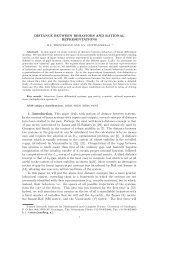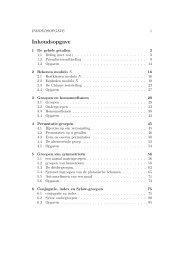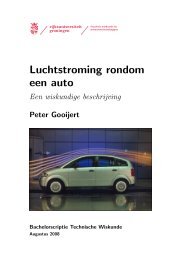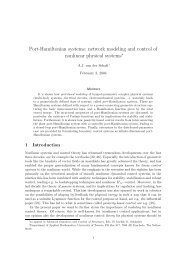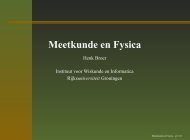Lecture 2: Controllability of nonlinear systems
Lecture 2: Controllability of nonlinear systems
Lecture 2: Controllability of nonlinear systems
Create successful ePaper yourself
Turn your PDF publications into a flip-book with our unique Google optimized e-Paper software.
DISC Systems and Control Theory <strong>of</strong> Nonlinear Systems 1<strong>Lecture</strong> 2:<strong>Controllability</strong> <strong>of</strong> <strong>nonlinear</strong> <strong>systems</strong>Nonlinear Dynamical Control Systems, Chapter 3See www.math.rug.nl/˜arjan (under teaching) for info on courseschedule and homework sets.Take-Home Exam I on homepage on March 16.
DISC Systems and Control Theory <strong>of</strong> Nonlinear Systems 2Recall: Kinematic model <strong>of</strong> the unicycleẋ 1 = u 1 cosx 3ẋ 2 = u 1 sinx 3ẋ 3 = u 2written as a system with two input vector fields and zero driftvector field⎡ ⎤ ⎡ ⎤cosx 3 0ẋ = ⎢⎣sin x 3⎥⎦ u 1 + ⎢⎣0⎥⎦ u 20 1The Lie bracket <strong>of</strong> the two input vector fields is given as⎡ ⎤ ⎡ ⎤ ⎡ ⎤0 0 − sinx 3 0 sinx 3− ⎢⎣0 0 cosx 3⎥ ⎢⎦ ⎣0⎥⎦ = ⎢⎣− cosx 3⎥⎦0 0 0 1 0
DISC Systems and Control Theory <strong>of</strong> Nonlinear Systems 3which is a vector field that is independent from the two inputvector fields.Claim: This new independent direction guarantees controllability<strong>of</strong> the unicycle system.Interpretation <strong>of</strong> the Lie bracket:Proposition 1 Let X, Y be two vector fields such that[X, Y ] = 0Then the solution flows <strong>of</strong> the vector fields are commuting.In fact, we may find local coordinates x 1 , . . .,x n such thatX = ∂∂x 1,Y = ∂∂x 2Thus, the Lie bracket [X, Y ] characterizes the amount <strong>of</strong>non-commutativity <strong>of</strong> the vector fields X, Y .
DISC Systems and Control Theory <strong>of</strong> Nonlinear Systems 4In fact, let the control strategy u = col(u 1 , u 2 ) be defined by⎧(1, 0), t ∈ [0, ε), ε > 0⎪⎨ (0, 1), t ∈ [ε, 2ε)u(t) =(−1, 0), t ∈ [2ε, 3ε)⎪⎩(0, −1), t ∈ [3ε, 4ε),Then the motion <strong>of</strong> the system is described byx(4ε) = x 0 + ε 2 [g 1 , g 2 ](x 0 ) + O(ε 3 ).which indicates controllability, since [g 1 , g 2 ] is everywhereindependent from g 1 , g 2 .This formula holds in general.This is enough for <strong>systems</strong> with two inputs and three statevariables, but what can we do if the dimension <strong>of</strong> the state is > 3?
DISC Systems and Control Theory <strong>of</strong> Nonlinear Systems 5Answer: consider higher-order Lie brackets.y r■θ▼ϕx rExample 2 Consider the cart with fixed rear axis⎡ ⎤ ⎡ ⎤ ⎡ ⎤x 1 cos(ϕ + θ) 0dx 2sin(ϕ + θ)0=udt ⎢⎣ ϕ ⎥ ⎢⎦ ⎣ sinθ ⎥ 1 +⎢⎦ ⎣ 0 ⎥⎦θ 01with u 1 the driving input, and u 2 the steering input.u 2
DISC Systems and Control Theory <strong>of</strong> Nonlinear Systems 6Defineg 1 (x) =⎡ ⎤cos(x 3 + x 4 )sin(x 3 + x 4 ), g⎢⎣ sin(x 4 ) ⎥ 2 (x) =⎦}0{{ }Drive⎡ ⎤00.⎢⎣ 0 ⎥⎦1} {{ }Steer
DISC Systems and Control Theory <strong>of</strong> Nonlinear Systems 7Compute[Steer, Drive] = ∂g 1∂x g 2 − ∂g 2∂x g 1⎡0 0 − sin(x 3 + x 4 ) − sin(x 3 + x 4 )0 0 cos(x 3 + x 4 ) cos(x 3 + x 4 )=⎢⎣ 0 0 0 cos(x 4 )0 0 0 0⎡⎤− sin(x 3 + x 4 )cos(x 3 + x 4 )==: Wriggle.⎢⎣ cos(x 4 ) ⎥⎦0⎤⎡⎥⎢⎦⎣0001⎤⎥⎦− 0
DISC Systems and Control Theory <strong>of</strong> Nonlinear Systems 8Another independent direction is obtained by the third-order Liebracket⎡ ⎤− sin(x 3 )cos(x 3 )[Wriggle, Drive] ==: Slide.⎢⎣ 0 ⎥⎦0This shows that you can manoeuver your car into any parking lotby applying controls corresponding to the ‘Slide’ direction, i.e., byapplying the control sequence {Wriggle, Drive, −Wriggle, −Drive}.
DISC Systems and Control Theory <strong>of</strong> Nonlinear Systems 9What to do with the drift vector field ?The systemẋ = f(x) + g(x)ucan be considered as a special case <strong>of</strong>ẋ = g 1 (x)u 1 + g 2 (x)u 2 ,with u 1 = 1. This means that care has to be taken with respect tobrackets involving f:[f, g], [g, [f, g]], [f, [f, g]], . . .
DISC Systems and Control Theory <strong>of</strong> Nonlinear Systems 10Example 3 Consider the system on R 2ẋ 1 = x 2 2ẋ 2 = u.Compute the Lie brackets <strong>of</strong> the vector fields⎡ ⎤ ⎡ ⎤f(x) =⎣ x2 20⎦, g(x) =⎣ 0 1⎦ ,yielding⎡⎤⎡⎤[f, g](x) =⎣ −2x 20⎦ , [[f, g], g](x) =⎣ 2 0⎦.Clearly, we have obtained two independent directions. However,since x 2 2 ≥ 0, the x 1 -coordinate is always non-decreasing. Hence,the system is not really controllable.
DISC Systems and Control Theory <strong>of</strong> Nonlinear Systems 11A weaker form <strong>of</strong> controllability: local accessibilityLet V be a neighborhood <strong>of</strong> x 0 , then R V (x 0 , t 1 ) denotes thereachable set from x 0 at time t 1 ≥ 0, following the trajectorieswhich remain in the neighborhood V <strong>of</strong> x 0 for t ≤ t 1 , i.e., all pointsx 1 for which there exists an input u(·) such that the evolution <strong>of</strong>the system for x(0) = x 0 satisfies x(t) ∈ V, 0 ≤ t ≤ t 1 , and x(t 1 ) = x 1 .Furthermore, letR V t 1(x 0 ) = ⋃R V (x 0 , τ).τ≤t 1Definition 4 (Local accessibility) A system is said to be locallyaccessible from x 0 if R V t 1(x 0 ) contains a non-empty open subset <strong>of</strong>X for all non-empty neighborhoods V <strong>of</strong> x 0 and all t 1 > 0. If thelatter holds for all x 0 ∈ X then the system is called locallyaccessible.
DISC Systems and Control Theory <strong>of</strong> Nonlinear Systems 12Definition 5 (Accessibility algebra) Consider the systemẋ = f(x) + g 1 (x)u 1 + · · · + g m (x)u mThe accessibility algebra C are the linear combinations <strong>of</strong>repeated Lie brackets <strong>of</strong> the form[X k , [X k−1 , [· · · , [X 2 , X 1 ] · · ·]]], k = 1, 2, . . .,where X i , is a vector field in the set {f, g 1 , . . .,g m }.This linear space is a Lie algebra under the Lie bracket.Definition 6 The accessibility distribution C is the distributiongenerated by the accessibility algebra C:C(x) = span{X(x) | X vector field in C}, x ∈ X
DISC Systems and Control Theory <strong>of</strong> Nonlinear Systems 13Intermezzo: Distributions on manifoldsA distribution D on a manifold X is specified by a subspaceD(x) ⊂ T x Xfor all x ∈ X.Let X 1 , X 2 , . . .,X k be vector fields on X. ThenD(x) = span(X 1 (x), X 2 (x), . . .,X k (x)).defines a distribution.A distribution D is called involutive if, whenever f, g ∈ D, also[f, g] ∈ D.The distribution D is called constant-dimensional whenever thedimension <strong>of</strong> D(x) is constant.
DISC Systems and Control Theory <strong>of</strong> Nonlinear Systems 14Example 7 Let X = R 3 and D = span(f 1 , f 2 ), wheref 1 (x) =⎡⎢⎣2x 210⎤⎥⎦ , f 2(x) =⎡⎢⎣⎤10 ⎥⎦ .x 2Since f 1 and f 2 are linearly independent, we have thatdim(D(x)) = 2, for all x. Furthermore, we have[f 1 , f 2 ](x) = ∂f 2∂x (x)f 1(x) − ∂f 1∂x (x)f 2(x) =⎡⎢⎣100⎤⎥⎦ .
DISC Systems and Control Theory <strong>of</strong> Nonlinear Systems 15[f 1 , f 2 ] ∈ D if and only if rank(f 1 (x), f 2 (x), [f 1 , f 2 ](x)) = 2, for all x.However,rank(f 1 (x), f 2 (x), [f 1 , f 2 ](x)) = rankfor all x. Hence, D is not involutive.⎡⎢⎣2x 2 1 01 0 00 x 2 1⎤⎥⎦ = 3,
DISC Systems and Control Theory <strong>of</strong> Nonlinear Systems 16Let D be a nonsingular distribution on X, generated by theindependent vector fields f 1 , . . .,f r . Then D is said to be integrableif for each x 0 ∈ X, there exists a neighborhood N <strong>of</strong> x 0 and n − rreal-valued independent functions h 1 (x), . . .,h n−r (x) defined on N,such that h 1 (x), . . .,h n−r (x) satisfy the partial differential equationsfor all indices i = 1, . . .,r, j = 1, . . .,n − r.Frobenius’ theorem∂h j∂x (x)f i(x) = 0, (1)A constant-dimensional distribution is integrable if and only if it isinvolutive.The necessity <strong>of</strong> involutivity for complete integrability is easilyseen. Indeed, suppose that (1) is satisfied. This is the same asL fi h j = 0
DISC Systems and Control Theory <strong>of</strong> Nonlinear Systems 17It follows thatL [fi ,f k ]h j = L fi L fk h j − L fk L fi h j = 0Since the functions h 1 (x), . . .,h n−r (x) are independent, this impliesthat the Lie brackets [f i , f k ] are (pointwise) linear combinations <strong>of</strong>the vector fields f 1 , . . .,f r , and are thus contained in thedistribution D.A geometric description <strong>of</strong> Frobenius’ theorem is as follows. Letthe independent functions h 1 (x), . . .,h n−r (x) satisfy (1). Then theirlevel sets, i.e., all sets <strong>of</strong> the form{x | h 1 (x) = c 1 , . . .,h n−r (x) = c n−r }for arbitrary constants c 1 , . . .,c n−r , are well-defined r-dimensionalsubmanifolds <strong>of</strong> X, to which all the vector fields f 1 , . . .,f r aretangent, and, as a consequence, also all their Lie brackets aretangent.
DISC Systems and Control Theory <strong>of</strong> Nonlinear Systems 18Example 8 Consider the following set <strong>of</strong> partial differentialequations0 = x 1∂φ∂x 1+ x 2∂φ∂x 2+ x 3∂φ∂x 30 = ∂φ∂x 3Define the vector fieldsf 1 (x) =⎡⎢⎣⎤ ⎡x 1x 2⎥⎦ , f 2(x) = ⎢⎣x 3001⎤⎥⎦ .It is checked that D := span(f 1 , f 2 ) has constant dimension = 2 onthe set X = {x ∈ R 3 | x 2 1 + x 2 2 ≠ 0} (that is, R 3 excluding the x 3 -axis),and is involutive. Thus, by Frobenius’ theorem, D is integrable.
DISC Systems and Control Theory <strong>of</strong> Nonlinear Systems 19Consequently, for each x 0 ∈ X, there exists a neighborhood N <strong>of</strong> x 0and a real-valued function φ(x) with dφ(x) ≠ 0 that satisfies thegiven set <strong>of</strong> partial differential equations. In fact, φ(x) = lnx 1 − lnx 2is a (global) solution.Note that the solution is not unique. In particular, φ(x) = tan −1 x 2x 1isalso a global solution.
DISC Systems and Control Theory <strong>of</strong> Nonlinear Systems 20By construction, the accessibility distribution C is involutive.Theorem 9 (Local accessibility) A sufficient condition for thesystem to be locally accessible from x ∈ X isdimC(x) = n (2)If this holds for all x ∈ X then the system is locally accessible.Conversely, if the system is locally accessible then (2) holds for allx in an open and dense subset <strong>of</strong> X.We call (2) the accessibility rank condition at x.
DISC Systems and Control Theory <strong>of</strong> Nonlinear Systems 21Key idea <strong>of</strong> the pro<strong>of</strong>Consider the systemẋ = f(x) + g 1 (x)u 1 + . . .g m (x)u mand its generated system vector fieldsF = {X | ∃u 1 , . . .,u m such that X(x) = f(x) + g 1 (x)u 1 + . . .g m (x)u m }Then for every k ≤ n there exists a submanifold N k around x 0 <strong>of</strong>dimension k given asN k = {x | x = X t kk ◦ Xt k−1k−1 ◦ · · · ◦ Xt 11 (x 0), 0 ≤ σ i < t i < τ i }with X i ∈ F. Indeed, suppose for a certain k < n we cannotconstruct N k+1 . This means that all system vector fields X ∈ F aretangent to N k , and hence all vector fields f, g 1 , . . .,g m . This alsomeans that all Lie brackets <strong>of</strong> these vector fields are tangent toN k , and thus dim C(x) ≤ k, which is a contradiction.
DISC Systems and Control Theory <strong>of</strong> Nonlinear Systems 22If there is no drift vector field then we obtain real controllability:Theorem 10 Considerẋ = g 1 (x)u 1 + g 2 (x)u 2 + . . . + g m (x)u mIf dimC(x) = n for all x ∈ X then the system is controllable.Consider the map(t 1 , . . .,t n ) → X t nn ◦ X t n−1n−1 ◦ · · · ◦ Xt 11 (x 0), 0 ≤ σ i < t i < τ ihaving image N n , which is an n-dimensional open part <strong>of</strong> X.Now let s 1 , . . .,s n be such that 0 ≤ σ i < s i < τ i . Then the map(t 1 , . . .,t n ) → (−X 1 ) s 1◦(−X 2 ) s 2◦· · ·◦(−X n ) s n◦X t nn ◦X t n−1n−1 ◦· · ·◦Xt 11 (x 0), 0 ≤ σ i < t i < τ ihas an image which is an open neighborhood <strong>of</strong> x 0 . Thus thereachable set R(x 0 ) from x 0 contains an open neighborhood <strong>of</strong> x 0 .
DISC Systems and Control Theory <strong>of</strong> Nonlinear Systems 23Suppose now that the reachable set is smaller than X. Then takeany point on the boundary <strong>of</strong> the reachable set R(x 0 ). Then the set<strong>of</strong> points reachable from this point is again open. Contradiction.Thus the unicycle and the cart are indeed controllable.Note that the actual construction <strong>of</strong> the input functions whichsteers the system from x 0 to x 1 has not been addressed.
DISC Systems and Control Theory <strong>of</strong> Nonlinear Systems 24Sometimes local accessibility is heavily depending on the flow <strong>of</strong>the drift vector field; consider for example the systemẋ 1 = 1ẋ 2 = uThis system is locally accessible, but <strong>of</strong> course very far fromcontrollability. In order to improve the situation we look at astronger form <strong>of</strong> accessibility: local strong accessibilityA system is locally strongly accessible from x 0 if for anyneighborhood V <strong>of</strong> x 0 the set R V (x 0 , t 1 ) contains a non-empty setfor any t 1 > 0 sufficiently small. If the latter holds for all x ∈ X thenthe system is called locally strongly accessible.(The example given above is not locally strongly accessible.)
DISC Systems and Control Theory <strong>of</strong> Nonlinear Systems 25Define C 0 as the smallest algebra which contains g 1 , . . .,g m andsatisfies [f, w] ∈ C 0 for all w ∈ C 0 . Define the correspondinginvolutive distributionC 0 (x) := span{X(x) | X vector field in C 0 }.We refer to C 0 and C 0 as the strong accessibility algebra and thestrong accessibility distribution, respectively.
DISC Systems and Control Theory <strong>of</strong> Nonlinear Systems 26Notice that the strong accessibility algebra C 0 does not contain thedrift vector field f).Theorem 11 (Strong accessibility) A sufficient condition for thesystem to be locally strongly accessible from x isdimC 0 (x) = nFurthermore, the system is locally strongly accessible if this holdsfor all x. Conversely, if the system is locally strongly accessiblethen it holds for all x in an open and dense subset <strong>of</strong> X.The system given before:ẋ 1 = x 2 2ẋ 2 = u.is not only locally accessible, but also locally strongly accessible,since g(x) and [[f, g], g](x) are everywhere independent.
DISC Systems and Control Theory <strong>of</strong> Nonlinear Systems 27Let us apply the theory developed above to a linear systemẋ = Ax +m∑b i u i , x ∈ R n ,i=1where b 1 , . . .,b m are the columns <strong>of</strong> the input matrix B.Clearly, the Lie brackets <strong>of</strong> the constant input vector fields given bythe input vectors b 1 , . . .,b m are all zero, i.e.,[b i , b j ] = 0, for all i, j = 1, . . .,m.Furthermore, the Lie bracket <strong>of</strong> the linear drift vector field Ax withan input vector field b i yields the constant vector field[Ax, b i ] = −Ab i .The Lie brackets <strong>of</strong> Ab i with Ab j or b j are again all zero, while[Ax, −Ab i ] = A 2 b i .
DISC Systems and Control Theory <strong>of</strong> Nonlinear Systems 28Hence we conclude that C is spanned by all constant vector fieldsb i , Ab i , A 2 b i , . . ., i ∈ m, together with the linear drift vector field Ax,i.e.,C = {Ax, b i , Ab i , A 2 b i . . .,A n−1 b i , i = 1, . . .,m}.whileC 0 = columns <strong>of</strong> (B, AB, A 2 B . . .,A n−1 B)We see that for linear <strong>systems</strong> the rank condition for strongaccessibility coincides with the Kalman rank condition forcontrollability. Hence, if we would not have known anything specialabout linear <strong>systems</strong>, then at least a linear system which satisfiesthe Kalman rank condition is locally strongly accessible.
DISC Systems and Control Theory <strong>of</strong> Nonlinear Systems 29Example 12 (Actuated rotating rigid body)Consider⎡ ⎤ ⎡ ⎤ ⎡ ⎤ ⎡ ⎤˙ω 1 A 1 ω 2 ω 3 α 1 0⎢⎣ ˙ω 2⎥⎦ = ⎢⎣A 2 ω 3 ω 1⎥⎦ + ⎢⎣ 0 ⎥⎦ u 1 + ⎢⎣α 2⎥⎦ u 2˙ω 3 A 3 ω 1 ω 2 0 0with α 1 ≠ 0, α 2 ≠ 0. Here the constants A 1 , A 2 , A 3 are determined bythe moments <strong>of</strong> inertia a 1 , a 2 , a 3 . Compute⎡ ⎤0[g 1 , f](ω) = ⎢⎣α 1 A 2 ω 3⎥⎦α 1 A 3 ω 2[g 2 , f](ω) =⎡ ⎤α 2 A 1 ω 3⎢⎣ 0 ⎥⎦α 2 A 3 ω 1
DISC Systems and Control Theory <strong>of</strong> Nonlinear Systems 30On the other hand⎡ ⎤0[g 2 , [g 1 , f]] = ⎢⎣ 0 ⎥⎦α 1 α 2 A 3Thus the system is locally strongly accessible ifA 3 ≠ 0which is equivalent to a 1 ≠ a 2 .In fact, this is the if and only if condition. Indeed, if A 3 = 0 then˙ω 3 = 0, showing that the system is not locally strongly accessible.Remark 13 Due to the specific properties <strong>of</strong> the drift vector field,i.c. Poisson stability, it can be shown that the system is in factcontrollable if and only if the two first moments <strong>of</strong> inertia a 1 anda 2 are different.)


